Street Art on Paper Street Art Mural on Brick Wall
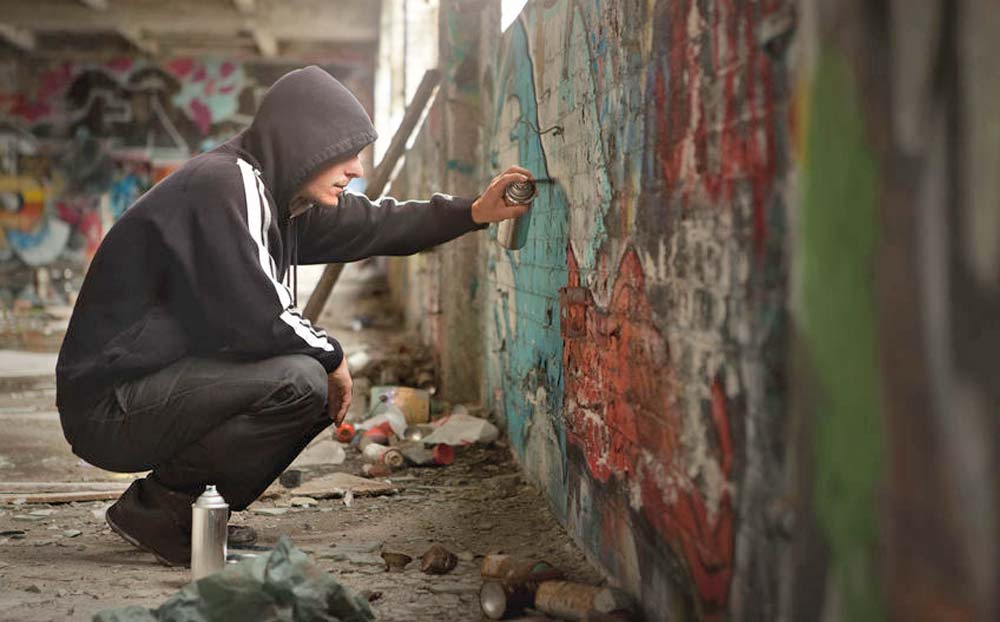
Is graffiti illegal?
Answer: If y'all do not have permission - YES information technology's illegal. If you accept permission - NO information technology's not illegal.
This is the style that information technology works in about places effectually the globe.
The reason that this is a confusing question is considering the word 'Graffiti' has ambiguous meanings. Since there is a mysterious aura to it, the boilerplate person might refer to the post-obit things as graffiti:
i) Whatsoever kind of drawing or words that were written without permission.
2) Anything drawn or written with spray paint.
3) Any kind of urban fine art that is displayed outdoors or on the street.
In order to properly understand this subject field, y'all must recognize these dissimilar categories. The 1st category above is mostly going to exist illegal. With the other two categories - information technology is not inherently a crime or not. It is going to depend on whether the artist received potency from the administrator of the property where the art is located.
Whether permission was provided is the deciding gene. Because paint, spray paint, brushes, etc are not illegal - the criminal offence frequently committed when deploying graffiti is vandalism. It is a grade of theft.
There is nix inherently illegal about cartoon a picture of a cat. Just if it is deployed on private property without the owner's permission - then information technology's illegal (in almost places). Another example is a spray-painted portrait of a person. A film of a face is not illegal in most places - in fact there are lots of faces displayed all over. What'due south illegal is spray painting on somebody else's property without their consent.
Ad

How to Tell if Legal or Not?
The question that arises from this is the following: how can you tell if a piece of urban art was made illegally or not?
A way to determine this is through a simple formula. Ask the following 2 questions:
A) What are the rules of the city/country, etc?
B) How much are these rules being enforced?
Based on the answers to these questions, you tin can estimate how much fourth dimension somebody would take to deploy illegal urban art. We can call this the 'illegal window' of time. And then you would estimate how long any individual artwork took to deploy. If it seems similar information technology was deployed in less time than the illegal window, then it was probably not authorized. If it seems like it took longer to deploy than the illegal window, then it probably was authorized.
Have New York Urban center as an instance. What are the rules? Very strict - if y'all are caught you volition be arrested immediately. How much are the rules enforced? Very aggressively - there are patrols, task forces, vandal squad detectives etc. Then figure that the illegal window of time is approx. 3 minutes. Therefore: if y'all see a piece of urban art in New York Metropolis that appears to accept taken longer than 3 minutes - assume it was immune. If information technology seems like information technology took less than three minutes - presume that it was illegal.
Advert

Potency
The ways that graffiti authorization works can vary. For case, in New York City authorization is very unproblematic: the owner of a property is the sole sectional authority over how it looks - including whatsoever paint or murals. So the owner can decide if they will allow an artist to paint on their property. The government is not in charge of information technology and is not involved. The opinion of other people - such every bit neighbors or customs members - is likewise irrelevant.
However information technology is different in other cities. Here are some of the most common municipal configurations regarding permission for street fine art:
i) Allow required for murals. The authorities targets vandalism and does non conduct a major initiative to spread murals around the city. If you want to make an authorized landscape, the property owner must corroborate and as well a permit must be obtained from the municipal government. Essentially the belongings owner must utilise for permission to display the artwork on their property.
2) Neutral on authorized fine art and no let required - like in NYC. The government targets vandalism but is essentially neutral on authorized urban art. There is no requirement to obtain a allow for art which a belongings owner has authorized. If it was deployed without permission - they will come up afterward you for this vandalism. If it was authorized past the holding possessor - it's legal and the government will have no action.
3) Major encouragement of authorized art - the government actively encourages people to pigment on municipal-controlled backdrop around the city. An instance of this is Philadelphia. They have a famous landscape program where artists are recruited to pigment on vacant backdrop and/or elsewhere. The rationale for this program is to adorn the city and to provide a legal platform to graffiti writers. Nonetheless vandalism (art that's deployed without permission) is still banned and enforced.
4) Total discouragement - the government tries to forestall Any spray pigment on walls (even authorized past property owners). For example, in London at that place are local councils which take banned spray paint on whatsoever property regardless of whether the owner wants it there. Annotation, even so, that spray painting in that location with the owner's permission is non a crime - information technology's only a violation of a civil ordinance. And the perpetrator of the ceremonious violation is the property owner, not the artist. For a crime you tin be arrested, for a civil ordinance violation you can probably receive a budgetary fine at worst. Only painting there without the possessor's permission is a criminal offence, and the perpetrator is the artist.
Delight note that in all of the configurations above, it's illegal to paint without the owner'southward permission. The rules which vary are only regarding the way you lot can obtain permission.

Types of Artists
In that location is a variety among the artists who make graffiti and urban art. They can be divided into 2 main types:
1) Graffiti author - an artist who deploys the original class of graffiti . They are writing their name, usually with stylized lettering. It is typically washed with spray paint, just information technology could exist with other materials too. The principal audience is other graffiti writers similar themselves. It might be illegally washed (usually lower quality) or authorized (typically college quality). Many graffiti writers likewise brand artworks that are not lettering (portraits, pictures etc), only their allegiance is to graffiti writing and they have spent substantial time honing their lettering skills. Graffiti writers are also known as 'taggers' or 'bombers.'
2) Street artist - an creative person who is making any other type of urban art which is non comprised of lettering. It can be whatever textile/presentation - paper, stencil, brush, sculpture, mural etc. The distinction between a street artist and a graffiti writer is that a street artist has not spent time honing their lettering skills. They create creative works which are deployed out in the street, but they practice not have a background of participating in the original class of graffiti writing. Many of them possess an advanced art pedagogy.


Advertizing
History of Graffiti & Street Art
Early days
Modern street graffiti began in New York Metropolis in the early 1970's (although the person who is credited as the world'southward first graffiti writer was a student in Philadelphia named Cornbread). Young teenagers growing up in impoverished, marginalized communities started "tagging" their names on walls in public places. These 'writers' created modify egos, aliases that frequently combined a nickname with a number. Often the digits were based on the street the tagger lived on. Early leaders in the tagging world included people with street aliases similar Fab5Freddy and Tracy168. These graffiti pioneers experimented with new styles and began the fad of tagging New York City's subway trains. This historic era of graffiti was when the main widely-accepted customs and slang language developed.
Recognition
While locally in New York graffiti was seen and treated as vandalism, enthusiasts in Europe recognized creative value in the "tagging" and brought these young writers to their continent to produce and showroom work. Graffiti was an instant striking in Europe and by the mid 1980's the writers, who in America were looked upon as criminals, were treated every bit celebrities in countries similar Italy and Frg. Over the 1980'southward there slowly began to be more recognition of graffiti artists in the US also. Some of the legendary pioneers were recruited to paint in music videos and on cable television.
Ascension of "Street Art"
Past the late 1980's the original celebrated graffiti era in New York had concluded and local writers proceeded to carry on and repeat the traditions and culture of their predecessors . Meanwhile in Europe the urban fine art movement was merely gaining traction. In the 1990's European artists experimented with new styles, which have get referred to as 'post-graffiti' or 'street art.' A French artist known as Blek Le Rat is attributed with introducing the stencil, a form of spray art which grew pop over the next decade. In recent years the stencil has been made famous by notorious British artist Banksy. Some other noteworthy artist is Frenchman Space Invader who illegally installs ceramic tiles that portray pixelated old video game characters.
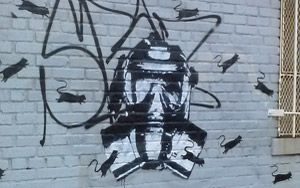
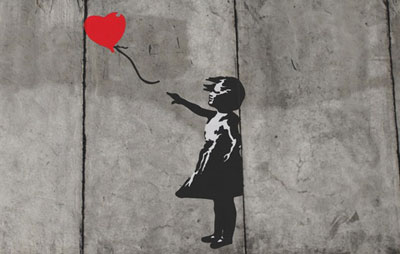
Mainstream Acceptance
By the 2000's, street fine art was followed effectually the globe and top artists became household names. United kingdom of great britain and northern ireland artist Banksy gained reverence and notoriety for his thought provoking images which appear in the unlikeliest of places. His work has subsequently commanded unheralded prices at top art auction houses. The ascent of the internet and social media has allowed for fans to follow their favorite artists, and for writers to collaborate across continents, cultures and linguistic communication barriers.
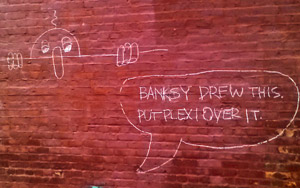
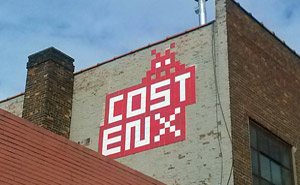
Controversy
The acceptance of street art into mainstream art circles has created social controversies. In late 2012 a Banksy slice disappeared from a London wall and resurfaced at a luxury art sale in Miami, Florida. Residents of its original London neighborhood expressed protest. They felt strongly that as a work of art it belonged to the community where it was created, and that information technology should be returned. The auction went ahead all the same and the piece was sold to a private collector for i.1 1000000 dollars!
Ad
Styles and Common Types of Street Fine art
Tags
Tags are words written in spray paint on a surface of whatever sort: including walls, storefronts, signs or doors. The words are normally the name of the person who wrote it; or their crew. They are generally just one color, a few inches in size or a couple of feet.
The traditional motivation of a tag is to create exposure for oneself and circulate the brazenness of taking the risk to spray pigment in a dangerous, inaccessible or openly public place. For a tag the main audience are other taggers. Larger productions known every bit "throw-ups" and "pieces" are more than stylized and feature multiple colors - although they follow the aforementioned premise equally tags and are also typically a name.
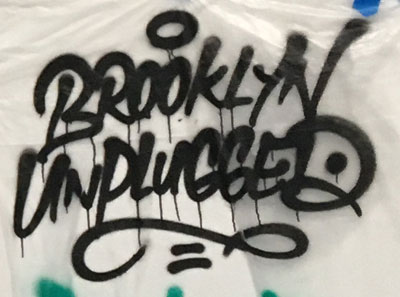

Murals
Murals are generally large and portray an image or scene. They ofttimes tell a story or limited feelings of the artist. Many of them carry a social or political critique, satire or message. Murals are generally larger than tags but come in all sizes. Today artists are granted permission or even paid to produce murals for public display on businesses and public buildings.
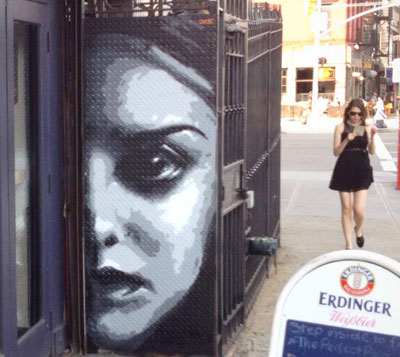
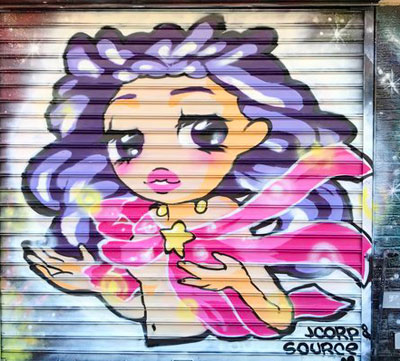
Posters/Paste-ups
Affiche art is commonly created in private, then brought to a public place and affixed to a surface. It is attached using an adhesive called wheat paste. In add-on to pigment, affiche art tin also contain multiple layers, cutouts, collages or stickers. The positive side to paste-up'south is that they tin can be deployed very apace. The down side is that they are more susceptible to weather condition atmospheric condition or destruction than spray paint. Therefore they tend to last less long than other graffiti mediums.
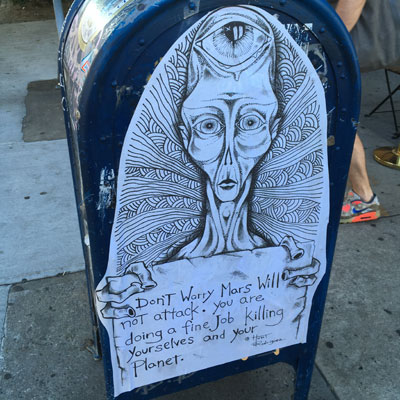
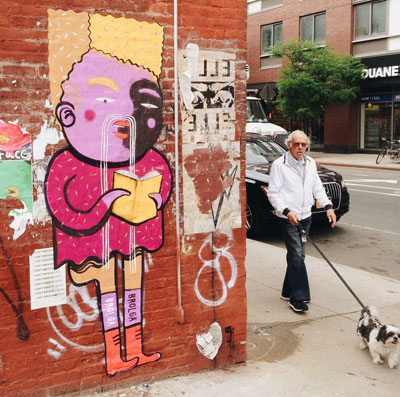
Conclusion
So, for the question of 'is graffiti illegal?' we have our reply: Information technology depends on whether information technology was authorized or non. And now you lot also accept a grasp of the different types of art that people refer to as 'graffiti.' Furthermore you have received some basic graffiti history, as well every bit common types of street art. So you are now in a position to understand these phenomenon meliorate!

Copyright Jeffrey Stirewalt 2019. Under no circumstances is this textile to be copied, sourced, referenced, reproduced etc. Whatsoever alienation of this copyright will be pursued aggressively under the Digital Millennium Act and through all possible legal channels. But please share this and link to it!
granberrythaniorefore1998.blogspot.com
Source: https://www.brooklynunpluggedtours.com/is-graffiti-illegal-crime
Posting Komentar untuk "Street Art on Paper Street Art Mural on Brick Wall"